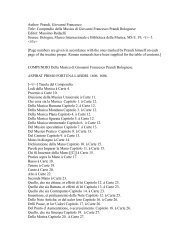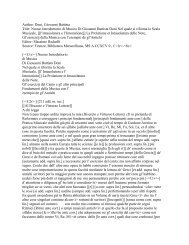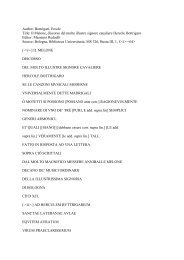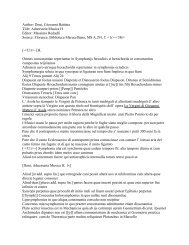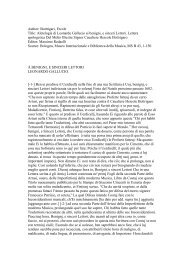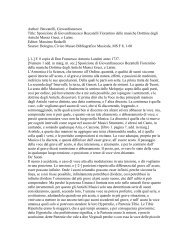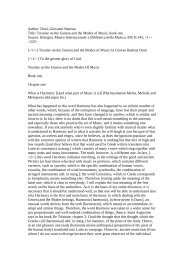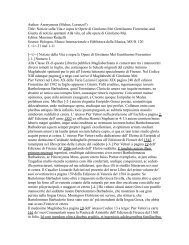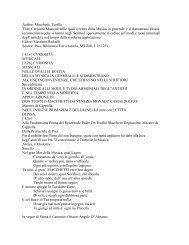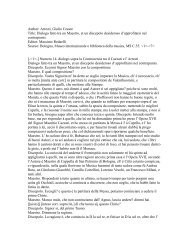Author: Dentice, Luigi - manuscripts of italian music theory in ...
Author: Dentice, Luigi - manuscripts of italian music theory in ...
Author: Dentice, Luigi - manuscripts of italian music theory in ...
Create successful ePaper yourself
Turn your PDF publications into a flip-book with our unique Google optimized e-Paper software.
unit. Now, <strong>in</strong> the sesquialtera proportion, the number two is the only one that is both their<br />
difference and divides one and the other exactly. If the proportion is sesquitertia, as<br />
between six and eight, the same number two is conta<strong>in</strong>ed exactly <strong>in</strong> one and the other,<br />
which does not occur <strong>in</strong> the other genera <strong>of</strong> <strong>in</strong>equality such as the superpartiente. In fact,<br />
if we consider the ration between five and three, the number two, which is their<br />
difference, is not conta<strong>in</strong>ed exactly <strong>in</strong> either <strong>of</strong> them, as, compared to the number three it<br />
is smaller and doubled it is greater. Hence, this type <strong>of</strong> <strong>in</strong>equality is not related to the<br />
nature <strong>of</strong> the consonances. Moreover, there are many similarities <strong>in</strong> the numbers that form<br />
the consonances. This is the demonstration. The number two is noth<strong>in</strong>g but twice the<br />
number one, the number three is three times one and the number four times one. The<br />
sesquialter is half <strong>of</strong> two, the sesquitertius a third <strong>of</strong> three, which is someth<strong>in</strong>g not easily<br />
found <strong>in</strong> the other species <strong>of</strong> <strong>in</strong>equality. However, among all the consonance that we have<br />
considered, one must judge diligently with the aid <strong>of</strong> the ear as well a <strong>of</strong> the m<strong>in</strong>d, to<br />
establish which is the best <strong>of</strong> them all, as the ear has the same relation to the sound as the<br />
eye to an object and the judgement <strong>of</strong> the m<strong>in</strong>d towards the numbers or the cont<strong>in</strong>uous<br />
quantity. In fact, given a number [-f.11r-] or a l<strong>in</strong>e, noth<strong>in</strong>g is easier than to consider its<br />
double with the eye or with the m<strong>in</strong>d. After the double, one has to consider <strong>in</strong> his m<strong>in</strong>d<br />
the half, after the half the triple, after the triple the third part. Thus, as it is easier to th<strong>in</strong>k<br />
<strong>of</strong> the double, accord<strong>in</strong>g to Nichomacus, the diapason would be the best consonance,<br />
followed by the diapente, which holds the half, and then the Diapente with the diatessaron<br />
which holds the triple. In this way and form Nichomacus considers the rest <strong>of</strong> the<br />
consonances.<br />
Serone. It is so. Therefore, we judge the <strong>in</strong>dividual quality <strong>of</strong> everyth<strong>in</strong>g through our<br />
senses, and so, if the consonance that is most regarded as such by everyone universally is<br />
the dupla, there is no doubt that the Diapason is the first <strong>of</strong> all the consonances.<br />
Soardo. This is because <strong>of</strong> the supremacy <strong>of</strong> the m<strong>in</strong>d, but, accord<strong>in</strong>g to the Pythagoreans,<br />
the others follow necessarily the sequence dictated by the widen<strong>in</strong>g <strong>of</strong> the multiplicity<br />
and narrow<strong>in</strong>g <strong>of</strong> the supraparticularity. Hence, it has been demonstrated that unequal<br />
multiplicity surpasses <strong>in</strong> antiquity the superparticular proportions. Therefore, if we lay out<br />
the natural number from the unit to the number four i. ii. iii. iiii. and we compare one and<br />
two, we shall see that the dupla proportion is created and the consonance <strong>of</strong> the diapason,<br />
which is known universally for its extreme simplicity. If we compare three and one, the<br />
union <strong>of</strong> the diapason and the diapente will be produced, while if we compare the number<br />
four and the number one, the result will be the quadrupla or the consonance <strong>of</strong> the<br />
bisdiapason. If we compare three with two, the product will be the diapente, while it will<br />
be the diatessaron if we compare four and three. As we said, this is the order result<strong>in</strong>g<br />
from the comparison <strong>of</strong> all <strong>of</strong> them with each other. In fact, the comparison between<br />
number four and number three falls <strong>in</strong>to the dupla proportion, as does the one between<br />
number two and number one, as we said above, hence the diapason will be the first <strong>of</strong><br />
them all; the second one will be the diapason with the diapente; the third one the<br />
bisdiapason; the fourth one the diapente and the fifth one [-f.11v-] the diatessaron.<br />
Nevertheless, Eubolides and Hippasus order the consonances <strong>in</strong> a difference sequence. In<br />
fact, they say that the <strong>in</strong>creas<strong>in</strong>g <strong>of</strong> multiplicity corresponds strictly to the decreas<strong>in</strong>g <strong>of</strong><br />
superparticularity, and thus there cannot be double without the half nor the triple without<br />
one third, so that, they say, s<strong>in</strong>ce it is double, the consonance <strong>of</strong> the diapason is produced,<br />
and, because it is one half, the sesquialtera proportion, which represents the diapente, is<br />
produced, as if by opposite division. They say that the two <strong>of</strong> them, namely the diapason<br />
and the diapente, added together produce the tripla, which conta<strong>in</strong>s both <strong>of</strong> those<br />
consonances, and also, by opposite division, the third part <strong>of</strong> the tripla, which produces<br />
the diatessaron, while the tripla and the sesquitertia added together produce the



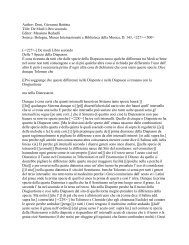
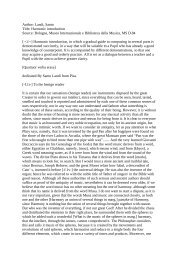
![Doni, Giovanni Battista Title: Trattato Dei Tuoni o [[Harmonie de]]](https://img.yumpu.com/45461005/1/190x245/doni-giovanni-battista-title-trattato-dei-tuoni-o-harmonie-de.jpg?quality=85)
